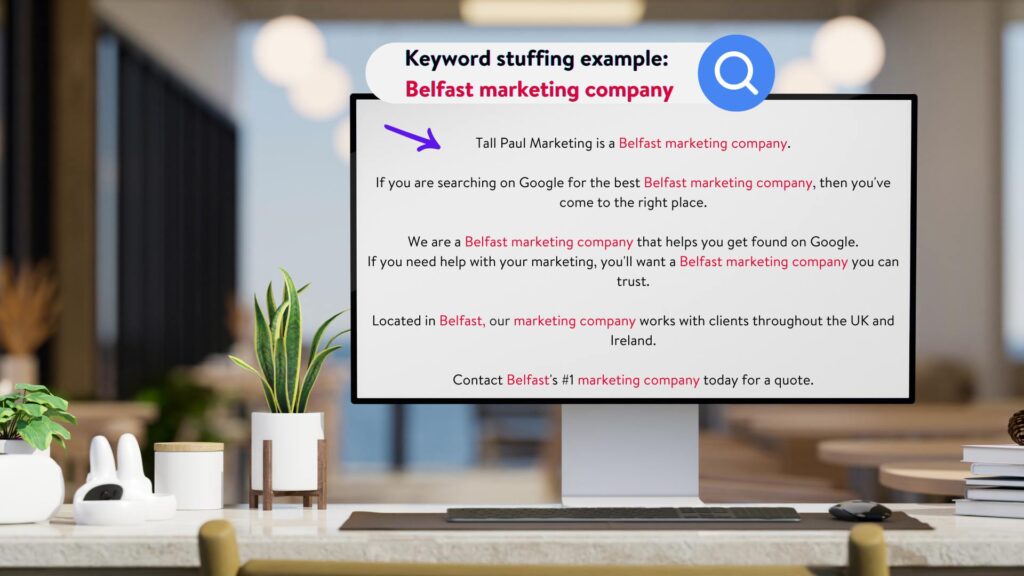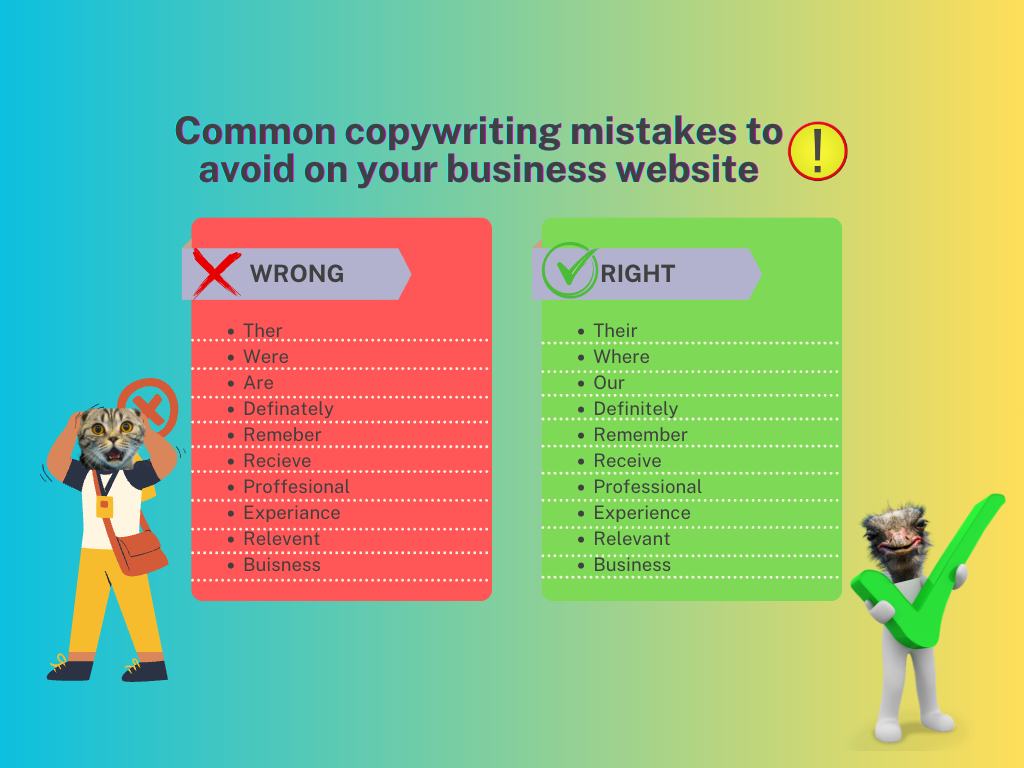
18 Common Copywriting Mistakes to Avoid on your Business Website (Part 1)
May 17, 2023
Increase Website Sales: Turning Visitors into Buyers (8 Tips)
August 23, 2023Last month, in part 1, I highlighted some of the common mistakes a freelance copywriter like me comes across on business websites when I’m reviewing and rewriting web copy. Today, in part 2, we’ll look at another nine copywriting mistakes that can affect your sales, brand reputation and ranking on Google.
PS: If you want to know the first nine things a freelance copywriter might come across on your website and you haven’t read Part 1 yet, it’s a good idea to start there: 18 Common Copywriting Mistakes to Avoid on your Business Website (Part 1)
10. Inconsistent branding.
Your website copy should align with the overall branding strategy of your business, including the brand voice, personality, and messaging.
Inconsistent branding on a business website can negatively impact your company’s overall perception and success.
A freelance copywriter looking through your website can spot inconsistent branding a mile off, and worse still, so can your potential customers.
Here are some reasons why inconsistent branding is terrible for a business website:
Lack of professionalism: Inconsistent branding creates an impression of a disorganised and unprofessional business.
It sends mixed messages to visitors, making it difficult for them to trust and engage with the brand.
Confusion: When a website lacks consistent branding elements such as logo, colours, fonts, and imagery, visitors may feel confused.
They may struggle to recognise the brand and navigate the website, leading to a poor user experience.
Weak brand recognition: Consistent branding is crucial for building brand recognition.
When branding elements are inconsistent across different web pages or marketing channels, it becomes challenging for customers to associate them with your brand.
This weakens your brand identity and makes it harder for your business to stand out in a competitive market.
Incoherent messaging: Inconsistent branding often results in incoherent messaging.
Different tones, styles, or visual elements can create confusion about your brand’s values, mission, and offerings.
This can dilute your marketing message and make it harder for potential customers to understand your business.
Reduced customer trust: Trust is vital in building customer relationships.
Inconsistent branding can erode trust, raising doubts about your business’s reliability and professionalism.
Customers may question the consistency and quality of your products or services, leading to a loss of credibility.
Missed marketing opportunities: Consistent branding enables you to create a cohesive marketing strategy.
When branding is inconsistent, you miss out on opportunities to effectively reinforce your messaging and connect with your target audience.
This can result in lower conversion rates and missed growth potential.
Negative impact on SEO: Inconsistent branding can harm your search engine optimisation (SEO) efforts.
Search engines prioritise websites with clear and consistent branding signals.
If your branding is inconsistent, it can affect your search rankings and make it harder for your website to appear in relevant search results.
To create a solid and memorable brand presence, it’s essential to maintain consistency across all touchpoints, including your business website.
Consistent branding helps establish trust, strengthens recognition, and ensures a cohesive user experience that aligns with your brand values and objectives.
11. Overuse of keywords: A good freelance copywriter will ensure all of your keywords and key phrases look natural.
Keyword stuffing, or the excessive use of keywords for SEO purposes, can make the website copy appear unnatural and spammy.
Keyword stuffing refers to excessively and unnaturally inserting keywords into website content to manipulate search engine rankings.
For example, in this article, my keywords are ‘freelance copywriter‘ – you’ll notice it sporadically throughout this blog post.
But if I started inserting ‘freelance copywriter’ into every second paragraph, that would look unnatural, wouldn’t it?
While once considered a common SEO tactic, keyword stuffing is now widely recognised as a bad practice with negative consequences.

It isn’t big. It isn’t cool. And keyword stuffing will annoy the hell out of your customers. Here’s an example of how a website might look if it’s stuffed with keywords for ‘Belfast marketing company’.
Here’s why keyword stuffing is wrong on a business website:
Poor User Experience: Keyword stuffing disrupts the flow and readability of website content.
When keywords are overused and forced into sentences, the text becomes awkward and difficult to understand.
Visitors may find reading and navigating through the content frustrating, resulting in a poor user experience.
Reduced credibility: Keyword stuffing diminishes the credibility and professionalism of your business.
When users encounter content that appears spammy and lacks value, they are less likely to trust the information provided or perceive the business as reputable.
It can negatively impact your brand’s reputation and discourage potential customers from engaging with your website.
Search engine penalties: Major search engines like Google actively discourage keyword stuffing.
They employ sophisticated algorithms to detect and penalise websites that engage in such practices.
Your website may experience a drop in search rankings, reduced visibility, or even be removed entirely from search results, harming your organic traffic and online presence.
Missed target audience engagement: Keyword stuffing often results in content not tailored to your target audience’s needs and interests.
Instead of providing valuable and relevant information, the focus is solely on incorporating keywords.
Consequently, you miss opportunities to engage and connect with your audience, potentially losing out on conversions and business opportunities.
Ineffective SEO strategy: Keyword stuffing is an outdated and ineffective SEO strategy.
Search engines now prioritise quality content that provides value to users.
Modern SEO practices focus on creating well-written, informative content that naturally incorporates relevant keywords.
By relying on keyword stuffing, you’re neglecting the opportunity to develop a robust and effective SEO strategy that aligns with current best practices.
Competitive disadvantage: Keyword stuffing does not give you a competitive edge in the long run.
Search engines continuously refine their algorithms to deliver the best search results to users.
Websites that use legitimate and user-focused SEO strategies will outperform those that rely on keyword stuffing.
Focusing on producing high-quality content that meets user intent and provides value is essential.
In summary, keyword stuffing harms the user experience, damages credibility, leads to search engine penalties, hinders audience engagement, and undermines your SEO efforts.
It’s essential to prioritise quality content creation, utilise keywords naturally and strategically, and focus on delivering value to your audience for long-term success.
12. Lack of target audience focus.
Website copy should be tailored to your target audience’s needs, interests, and pain points.
If the copy does not resonate with the intended audience, it may fail to capture their attention.
For example, as a freelance copywriter, I know my target audience: marketing managers, CEOs, communications officers and Northern Ireland business owners.
A lack of target audience focus on a business website can harm the overall success and effectiveness of your online presence.
Here are several reasons why it’s terrible:
Missed connection with customers: A business website should be designed to resonate with your target audience.
If you fail to understand and address their specific needs, interests, and pain points, you miss the opportunity to connect with them on a deeper level.
Without this connection, visitors are likelier to bounce off your website without taking any desired actions or engaging with your brand.
Ineffective messaging: When your website lacks a target audience focus, your messaging becomes generic and diluted.
Your content may not effectively communicate the unique value proposition of your products or services to the people who are most likely to be interested in them.
This can result in a lack of engagement and lower conversion rates.
Poor User Experience: A business website that doesn’t consider the target audience’s preferences, behaviours, and expectations can lead to a bad user experience.
Visitors may struggle to find the information they’re looking for, navigate through the website, or understand how your offerings solve their specific problems.
This can result in frustration, confusion, and a negative perception of your brand.
Wasted resources: Without a clear understanding of your target audience, you may waste resources on ineffective marketing strategies, advertising campaigns, and website optimisations.
By not focusing on the right audience, you risk investing time, money, and effort in activities that yield low returns and fail to generate meaningful results for your business.
Lost competitive advantage: Understanding your target audience gives you a competitive advantage by enabling you to tailor your offerings, messaging, and user experience to meet their specific needs better than your competitors.
Failing to do so allows competitors with a stronger focus on their target audience to capture the attention and loyalty of potential customers.
Decreased customer loyalty and advocacy: When your website fails to resonate with your target audience, it becomes harder to build long-term customer loyalty and advocacy.
Customers are more likely to connect with brands that understand and cater to their unique preferences and provide personalised experiences.
Neglecting your target audience can result in missed opportunities to build lasting customer relationships.
To create an effective business website, investing time in understanding your target audience is crucial.
Conduct market research, analyse customer demographics, preferences, and behaviours, and use this information to inform your website’s design, content, and overall user experience.
By focusing on your target audience, you can deliver a more compelling and personalised experience that resonates with potential customers, increases engagement, and drives business growth.
13. Lack of proofreading (A freelance copywriter can help you with this)
Failing to proofread your website copy for errors can result in grammatical mistakes, typos, and other errors that can negatively impact the credibility of your brand.
A lack of proofreading on a business website can have various negative consequences.
Here’s why it’s essential to prioritise proofreading:
Errors and mistakes: Failing to proofread your website content can lead to grammatical errors, spelling mistakes, and inconsistencies.
These errors can undermine the professionalism and credibility of your business.
Visitors may perceive such mistakes as a lack of attention to detail or a reflection of poor quality standards, which can negatively impact their trust in your brand.
Miscommunication and confusion: Proofreading ensures your website content effectively communicates your message.
Content containing errors or unclear sentences can confuse visitors and make it challenging for them to understand your offerings, policies, or instructions.
This can lead to frustration, missed opportunities, and a negative user experience.
Damaged brand image: A business website is often the first point of contact for potential customers.
A lack of proofreading can result in content that appears unprofessional and careless.
Poorly written or error-ridden content can damage your brand image, making establishing trust and credibility with visitors difficult.
Presenting a polished and well-crafted online presence is vital to leave a positive impression on your audience.

“We our in buisness over ten years.” Silly spelling mistakes like these can cost you big time.
Decreased conversion rates: Errors and mistakes on your website can negatively impact your conversion rates.
When visitors encounter unclear or confusing content, they may hesitate to take the desired actions, such as purchasing, subscribing to a service, or filling out a form.
Precise, error-free content is more likely to inspire confidence and encourage visitors to engage with your business.
Missed SEO opportunities: Proofreading plays a role in search engine optimisation (SEO).
Search engines favour high-quality, well-written, error-free content that provides value to users.
If your website contains spelling or grammar mistakes, it can negatively impact your search rankings.
Indeed, as a freelance copywriter, one of the first things I do, when I have a quick look through a client’s website, is check whether their spelling and grammar are on point.
Additionally, accurate proofreading ensures that your targeted keywords are used correctly, helping to optimise your content for search engines.
Poor User Experience: A website with errors and mistakes can lead to a poor user experience.
Visitors may become frustrated or lose trust in your website and leave without engaging further.
By proofreading your content, you enhance the user experience by ensuring it is clear, coherent, and error-free, leading to improved engagement and increased satisfaction.
It’s crucial to incorporate a thorough proofreading process into your website content creation and maintenance to avoid these negative consequences.
This may involve having a dedicated proofreader, using spelling and grammar tools, and conducting multiple rounds of revisions to catch any errors or inconsistencies.
Prioritising proofreading helps you present a professional and polished image, communicate effectively with your audience, and improve the overall user experience on your business website.
14. Lack of a Unique Selling Proposition (USP).
Website copy should communicate the unique value proposition of your products or services.
The copy may fail to differentiate your brand from competitors without a strong USP.
A lack of a Unique Selling Proposition (USP) on a business website can hinder your ability to differentiate yourself from competitors and effectively communicate the value you offer to your target audience.
Here are reasons why a lack of USP is detrimental:
Increased competition: Without a clear USP, your business becomes susceptible to blending in with the competition.
Customers may struggle to identify what sets you apart and why they should choose your products or services over others.
This lack of differentiation can make attracting and retaining customers in a crowded marketplace difficult.
Missed opportunity to highlight benefits: Your USP allows you to highlight your offerings’ unique benefits and advantages.
It is your chance to communicate why customers should choose your business and how it can fulfil their specific needs or solve their problems better than other alternatives.
Without a strong USP, you miss the opportunity to showcase these distinctive benefits and may fail to capture the attention and interest of your target audience.
Ineffective marketing messaging: A USP forms the foundation of your marketing messaging and communication strategy.
It helps you craft compelling and persuasive content that resonates with your audience.
Without a clear USP, your marketing messages may become vague, generic, or inconsistent, making creating impactful and memorable campaigns harder.
Reduced customer engagement: A USP helps create an emotional connection with your target audience.
When you clearly communicate your unique value, customers can relate to your brand and develop a sense of loyalty.
Without a compelling USP, you risk losing customer engagement and loyalty, as they may perceive your business as interchangeable with others in the market.
Weakened pricing power: A strong USP allows you to position your offerings based on value rather than price.
When customers perceive your business’s unique benefit or advantage, they are often willing to pay a premium.
Without a USP, your pricing power may be weakened, and you may be forced to compete solely on price, leading to decreased profitability.
Difficulty in targeting the right audience: Your USP helps you define and target the right audience.
It enables you to identify the specific customer segment that values your unique offering and is more likely to convert into loyal customers.
Without a clear USP, you may struggle to attract and connect with the right audience, resulting in inefficient marketing efforts and a diluted customer base.
To address a lack of USP on your business website, it’s essential to conduct a thorough analysis of your products, services, and target audience.
Identify what sets your business apart from competitors and develop a compelling USP that resonates with your target market.
Incorporate this USP into your website content, messaging, and branding to effectively communicate your value proposition and differentiate your business from others in the market.
15. Lack of social proof.
Testimonials, case studies, and other forms of social proof are essential in building trust and credibility.
According to HubSpot, 91% of consumers trust recommendations from people they know, and 70% trust customer opinions posted online.
As a freelance copywriter, I place testimonials high on my list of priorities to market my own copywriting services: see how I’ve used social proof throughout my copywriting portfolio.
A lack of social proof on a business website can be detrimental for several reasons:
Trust and credibility: Social proof, such as customer testimonials, reviews, or endorsements, helps establish trust and credibility for a business.
When potential customers visit a website and see the positive feedback from others who have used the product or service, it reassures them that the business is reliable and trustworthy.
Without social proof, visitors may hesitate to engage with the business or purchase.
Influence on decision-making: Social proof plays a significant role in influencing consumer behaviour.
People tend to look for social cues and validation from others before making a decision.
If a business website lacks social proof, potential customers may be less likely to convert or take the desired action because they don’t have evidence that others have had positive experiences with the business.
Competitive disadvantage: In a competitive market, businesses that can showcase positive social proof have an advantage over those that don’t.
Customers are more likely to choose a business with a track record of satisfied customers or positive reviews than one without social proof.
Without social proof, a business may struggle to stand out from competitors and attract new customers.
Perception of popularity and quality: Social proof can create a perception of popularity and quality for a business.
When people see that others have engaged with the business and had positive experiences, it creates a sense of desirability and increases the perceived value of the product or service.
Potential customers may perceive the business as less popular or of lower quality without social proof, hindering their willingness to engage.
Word-of-mouth marketing: Social proof can act as a catalyst for word-of-mouth marketing, where satisfied customers recommend the business to others.
When people have positive experiences and see the social proof on a website, they are likelier to share their experiences with their networks, leading to increased brand awareness and customer acquisition.
And it really does work; when a client is happy with the copywriting service I’ve provided as a freelance copywriter, they’re more likely – and usually do – tell others about my skillset.
Without social proof, the potential for positive word-of-mouth marketing diminishes.
In summary, lacking social proof on a business website can undermine trust, credibility, and customer decision-making.
It can put a business at a competitive disadvantage and hinder its ability to attract new customers.
Incorporating social proof into a website can help build trust, influence consumer behaviour, and create a positive perception of the business.
16. Ignoring Mobile Optimisation.
You might have hired the best freelance copywriter in Ireland, but if your website isn’t mobile-optimised, then the quality of your website copy won’t matter.
With the increasing use of mobile devices for browsing, ensuring that the website copy is optimised for mobile viewing is essential.
Ignoring mobile optimisation can result in poor user experience and high bounce rates.
And ignoring mobile optimisation for a website can significantly negatively affect a business.
Here’s why:
User experience: Mobile devices, such as smartphones and tablets, have become many users’ primary means of internet access.
If a website is not optimised for mobile devices, it will provide a poor user experience.
The content may be challenging to read, buttons and links may be hard to click, and the overall layout may appear distorted or unusable.
Frustrated users will likely abandon such a website and seek alternatives that provide a better mobile experience.
Decreased visibility: Mobile optimisation is essential for search engine optimisation (SEO).
Search engines like Google prioritise mobile-friendly websites in their search results.
If a website is not optimised for mobile, it may receive lower rankings in mobile search results, resulting in decreased visibility and lower organic traffic.
High bounce rates: A website that is not mobile-friendly will likely have high bounce rates.
When visitors encounter difficulties accessing or navigating a website on their mobile devices, they are more likely to leave immediately and seek other options.
This can lead to missed opportunities for engagement, conversions, and sales.
Negative brand perception: A poorly optimised website reflects poorly on a business’s brand image.
Users may perceive a lack of professionalism, attention to detail, or an outdated approach.
In contrast, a mobile-optimised website conveys a positive brand image, showing that the business is technologically savvy, customer-centric, and committed to delivering a seamless experience across devices.
Lost conversions and revenue: If a website is not optimised for mobile, it can result in lost conversions and revenue.
Mobile users may abandon shopping carts, forms, or checkout processes if they encounter difficulties or frustrations.
By neglecting mobile optimisation, a business risks losing potential customers and revenue.
Competitive disadvantage: Mobile optimisation is the norm rather than the exception in today’s digital landscape.
Businesses that fail to optimise their websites for mobile devices put themselves at a competitive disadvantage.
Competitors with mobile-friendly websites will attract more mobile traffic, engage users effectively, and potentially capture the market share that the non-optimised business could have attained.
To avoid these negative impacts, businesses must prioritise mobile optimisation.
This involves using responsive web design techniques, optimising page load times, ensuring easy navigation, and adapting content for mobile screens.
By providing a seamless mobile experience, businesses can enhance user satisfaction, improve search engine visibility, and drive conversions and revenue.
17. Lack of emotion: A freelance copywriter like me can make your copy relate to your target customers.
Website copy should evoke emotions and create a connection with the audience.
If your copy lacks emotional appeal, it may fail to resonate with site visitors.
While emotions may not seem directly relevant to business websites, a lack of emotion can have negative implications for various aspects of a business website’s effectiveness:
User engagement: Emotions are powerful motivators for user engagement.
Visitors may feel indifferent or uninterested when a website fails to evoke any emotional response, leading to a lack of engagement.
Emotional elements such as compelling visuals, persuasive copywriting, or relatable storytelling can capture users’ attention and encourage them to explore further, take desired actions, or purchase.
Brand differentiation: Emotions can help businesses differentiate themselves from competitors.
By evoking specific emotions that align with their brand values and messaging, businesses can create a unique identity that resonates with their target audience.
Without emotional elements, a website may appear generic and fail to establish a distinct brand personality, making it harder to stand out in a crowded marketplace.
Trust and connection: Emotions are vital in building trust and establishing a relationship with website visitors.
Emotional cues, such as testimonials, case studies, or customer stories, can create a sense of authenticity, credibility, and empathy.
A lack of emotional elements can make it challenging for visitors to connect with the brand, perceive its value, or trust its offerings, potentially hindering conversions and customer loyalty.

If they aren’t laughing, crying, smiling, pondering, grinning or relating to your company, then you’re doing it wrong.
User Experience: Emotions can enhance the overall user experience of a website.
Positive emotions, such as joy or delight, can make the browsing experience more enjoyable, memorable, and shareable.
Conversely, negative emotions, such as frustration or confusion, can lead to a poor user experience and drive visitors away.
Businesses can create a more engaging, intuitive, and user-friendly website by incorporating emotional elements.
Storytelling and persuasion: Emotions are integral to compelling storytelling and persuasion.
Humans are wired to respond to narratives that elicit emotions, as they help us connect with information on a deeper level.
Through emotional storytelling, businesses can convey their brand story, values, and benefits compellingly and memorably.
Without emotions, the website’s messaging may become dry, uninspiring, and less persuasive.
Social sharing: Emotionally evocative content is more likely to be shared on social media platforms and go viral.
When users feel emotionally moved by a website’s content, they are likelier to share it with others, leading to increased visibility and brand exposure.
A lack of emotional elements can limit the website’s potential for social sharing and hinder its ability to reach a wider audience.
In summary, a lack of emotion on a business website can negatively impact user engagement, brand differentiation, trust-building, user experience, storytelling, persuasion, and social sharing.
By incorporating emotional elements strategically, businesses can create more memorable, impactful, and effective websites that resonate with their target audience and drive business success.
Consider hiring a freelance copywriter who can engage your audience with emotion-driven content.
18. Lack of benefits-focused headings.
Headings and subheadings should convey the benefits of your products or services.
Having benefits-focused headings on a business website is crucial for effectively communicating the value and advantages that a product or service offers to potential customers.
Here are some reasons why a lack of benefits-focused headings can be detrimental:
Unclear Value Proposition: Benefits-focused headings help clarify the unique value and benefits that customers can derive from a product or service.
Without clear headings highlighting the advantages, visitors may struggle to understand why they should choose your offering over competitors.
As a result, they may lose interest and navigate away from your website.
Failure to address customer needs: Benefits-focused headings address your target audience’s specific needs and pain points.
You can capture their attention and demonstrate relevance by clearly communicating how your product or service solves their problems or fulfils their desires.
Without these headings, visitors may not immediately see how your offering addresses their needs, leading to disengagement.
Missed emotional connection: Benefits-focused headings have the potential to evoke positive emotions in visitors.
Seeing the direct benefits they will experience, such as saving time, money, or effort or achieving their goals more effectively, creates an emotional connection and motivates them to explore further.
Visitors may have difficulty forming a strong connection with your brand without these emotional triggers.
Reduced conversion rates: Benefits-focused headings play a crucial role in driving conversions.
When visitors can quickly understand the value they will gain by engaging with your product or service, they are more likely to take the desired action, whether it’s making a purchase, signing up for a newsletter, or requesting more information.
Without clear benefits-focused headings, you may experience lower conversion rates as visitors struggle to grasp the value proposition.
Competitive disadvantage: In a competitive market, businesses that effectively highlight the benefits of their offerings have a better chance of capturing customers’ attention and standing out from competitors.
If your website lacks benefits-focused headings while competitors have them, you risk losing potential customers to those who more clearly communicate the advantages they offer.
To address the lack of benefits-focused headings on a business website:
Identify critical benefits: Determine the core benefits that your product or service provides to your target audience.
Consider what problems you solve, what value you add, and what outcomes or improvements customers can expect.
Craft clear and compelling Headings: Develop headings that explicitly highlight the specific benefits customers will gain.
Use concise and persuasive language to communicate the advantages in a way that resonates with your target audience.
Test and refine: Monitor the effectiveness of your benefits-focused headings by tracking website analytics and conversion rates.
Experiment with different variations, test them and adjust based on the data and user feedback to optimise their impact.
Remember to align your benefits-focused headings with your website’s overall messaging, design, and user experience to ensure consistency and clarity throughout.
If you need help, a professional freelance copywriter can help you hone in on what’s important in your business and create those benefits-focused headings for you.
Ready to take your web content to the next level? Let my words work their magic for your business. As a professional freelance copywriter, I’m here to help you captivate your audience, boost engagement, and drive conversions.
Contact freelance copywriter Tall Paul today to learn more about my freelance web content writing and blog writing services and how I can help your business.





